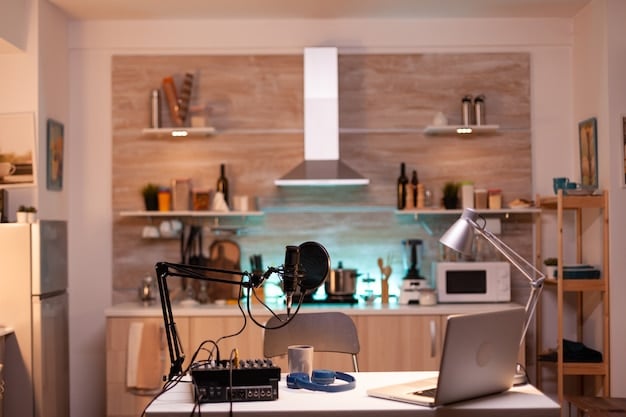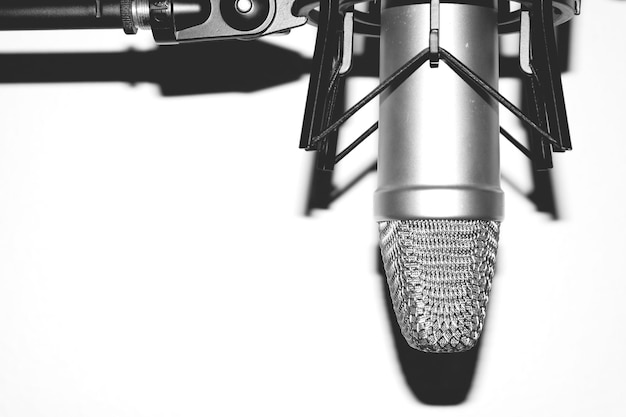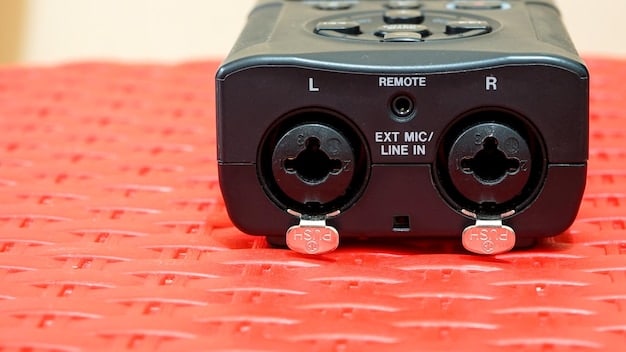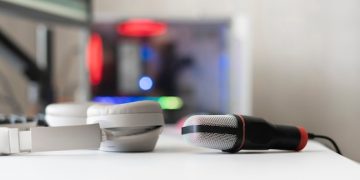Podcast Interview Gear: Sound Professional in the US Market

Podcast Interview Gear Essentials: What You Need to Sound Professional in the US Market covers the essential equipment and tools necessary to produce high-quality podcast interviews, focusing on microphones, headphones, audio interfaces, and software that ensures professional sound for US-based audiences.
Creating a professional-sounding podcast interview is within everyone’s reach with the right equipment. Investing in key gear not only elevates your audio quality but also enhances the overall listening experience. Let’s delve into the podcast interview gear essentials: what you need to sound professional in the US market.
Microphone Selection: The Cornerstone of Quality Audio
Choosing the right microphone is fundamental to capturing clear and crisp audio. Different microphones cater to various recording environments and vocal styles, so understanding the options is crucial.
Dynamic Microphones
Dynamic microphones are known for their durability and ability to handle high sound pressure levels. They’re also less sensitive to background noise, making them ideal for less-than-perfect recording environments.
Condenser Microphones
Condenser microphones are more sensitive and capture a wider frequency range, resulting in detailed and nuanced recordings. They require phantom power, usually supplied by an audio interface.
When choosing a microphone, consider these points:
- Polar Pattern: Understand the pickup pattern (cardioid, omnidirectional, bidirectional) to minimize unwanted noise.
- Frequency Response: Look for a microphone with a frequency response that complements your voice.
- Budget: Balance quality with affordability. Entry-level options can still deliver excellent results.

Selecting the right microphone sets the stage for high-quality audio. Consider your recording environment and vocal characteristics to make the best choice.
Headphones: Monitoring and Clarity
Headphones are essential for monitoring audio during recording and editing. They allow you to hear yourself and your guest clearly, ensuring that you’re capturing the best possible sound.
Closed-Back Headphones
Closed-back headphones prevent sound from leaking out, which is crucial for recording. They provide excellent isolation, allowing you to focus on the audio without distractions.
Open-Back Headphones
Open-back headphones offer a more natural and spacious sound, which is ideal for mixing and mastering. However, they’re not suitable for recording due to sound leakage.
Consider these factors when choosing headphones:
- Comfort: Look for headphones with comfortable ear cups and adjustable headbands for long recording sessions.
- Sound Quality: Choose headphones with a flat frequency response for accurate monitoring.
- Durability: Invest in headphones that can withstand regular use.
High-quality headphones are crucial for accurate monitoring and editing. Choose a pair that provides comfort, excellent sound quality and sound isolation.
Audio Interface: The Hub of Your Recording Setup
An audio interface is a central component of a professional podcasting setup. It converts analog signals from your microphone into digital signals that your computer can understand.
Key Features of an Audio Interface
Look for an audio interface with these features:
- XLR Inputs: Ensure the interface has XLR inputs for connecting professional-grade microphones.
- Phantom Power: Phantom power (48V) is necessary for condenser microphones to function.
- Low Latency: Low latency is crucial for real-time monitoring without delays.
- Multiple Inputs: If you plan to record multiple guests simultaneously, choose an interface with multiple inputs.
Popular Audio Interfaces
Here are a few popular audio interfaces for podcasting:
- Focusrite Scarlett Series: Known for its user-friendly interface and excellent sound quality.
- PreSonus AudioBox Series: Affordable and reliable, suitable for beginners and experienced podcasters alike.
- Universal Audio Apollo Series: High-end interfaces with advanced features and exceptional sound quality.

An audio interface is essential for converting analog signals into digital ones. Select one with features that suit your specific recording, monitoring, and interface requirements.
Recording and Editing Software: Polishing Your Audio
Recording and editing software, also known as a Digital Audio Workstation (DAW), is crucial for polishing your audio. DAWs allow you to record, edit, mix, and master your podcast episodes.
Popular DAWs for Podcasting
Here are a few popular DAWs for podcasting:
- Audacity: A free and open-source DAW that’s perfect for beginners.
- GarageBand: A free DAW that comes with macOS, offering a user-friendly interface and a range of features.
- Adobe Audition: A professional-grade DAW with advanced editing and mixing capabilities.
- Descript: A modern audio and video editing tool that focuses on ease of use and transcription-based editing.
Key features to look for in a DAW include:
- Multi-track recording: Record multiple audio sources simultaneously.
- Editing tools: Trim, cut, copy, and paste audio segments with ease.
- Noise reduction: Remove background noise and unwanted sounds.
- EQ and compression: Adjust the frequency balance and dynamic range of your audio.
Choosing the right DAW helps you in editing to create professional podcasts. Ensure that it meets your editing requirements.
Acoustic Treatment: Minimizing Echo and Reverberation
Acoustic treatment is the process of improving the sound quality of a room by reducing echo and reverberation. Even the best equipment cannot compensate for a poor acoustic environment.
DIY Acoustic Treatment
You can improve your recording environment with DIY solutions such as:
- Acoustic Panels: Cover walls with acoustic panels made from foam or fiberglass.
- Bass Traps: Place bass traps in corners to absorb low-frequency sounds.
- Moving Blankets: Hang moving blankets on walls to dampen sound reflections.
Professional Acoustic Treatment
For more effective acoustic treatment, you can invest in professional solutions such as:
- Acoustic Foam: Available in various shapes and sizes, acoustic foam is designed to absorb sound waves.
- Acoustic Curtains: Heavy curtains can absorb sound and reduce echo.
Proper acoustic treatment enhances the sound quality of your space during recording.
Accessories: Completing Your Setup
In addition to the core equipment, several accessories can enhance your podcasting setup and improve the overall recording experience.
Essential Accessories
Consider these accessories:
- Microphone Stand: A sturdy microphone stand ensures proper positioning and reduces handling noise.
- Pop Filter: A pop filter reduces plosives (bursts of air from “p” and “b” sounds) for clearer recordings.
- Shock Mount: A shock mount isolates the microphone from vibrations, reducing unwanted noise.
- XLR Cables: High-quality XLR cables ensure a clean and reliable signal transfer.
Optional Accessories
These will further aid in your quest to professional content:
- Headphone Amplifier: A headphone amplifier boosts the signal to your headphones, improving monitoring clarity.
- Audio Mixer: Provides greater control over your audio levels and allows you to mix multiple sources in real-time.
With these accessories, take steps toward creating the perfect podcast setup.
| Key Element | Brief Description |
|---|---|
| 🎤 Microphone | Captures clear audio; choose dynamic or condenser based on environment. |
| 🎧 Headphones | Monitors audio during recording; closed-back for recording, open-back for mixing. |
| 🎛️ Audio Interface | Converts analog to digital signals; essential for XLR inputs and phantom power. |
| 🎶 Software (DAW) | Edits audio; options: Audacity, GarageBand, Adobe Audition, Descript. |
Frequently Asked Questions
▼
Dynamic microphones, like the Shure SM7B, are often preferred for their ability to handle high sound pressure levels and reject background noise, making them ideal for various recording environments.
▼
An audio interface converts analog signals from microphones into digital signals that your computer can understand. It also provides XLR inputs, phantom power, and low-latency monitoring.
▼
It’s best to avoid open-back headphones for recording because they leak sound, which your microphone can pick up, leading to unwanted noise and echo in your recording.
▼
Acoustic treatment involves improving room sound quality by reducing echo and reverberation. It’s crucial because even top-tier equipment can’t compensate for poor acoustics, ensuring clearer recordings.
▼
For beginners, Audacity and GarageBand are recommended. Audacity is a free, open-source option, while GarageBand comes free with macOS, both offering user-friendly interfaces and essential features.
Conclusion
Investing in the right podcast interview gear essentials: what you need to sound professional in the US market significantly elevates your podcast’s quality and listener experience. By focusing on microphone selection, headphones, audio interfaces, recording software, acoustic treatment, and essential accessories, you’re well-equipped to create professional, high-quality podcast interviews.





